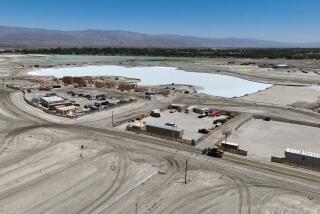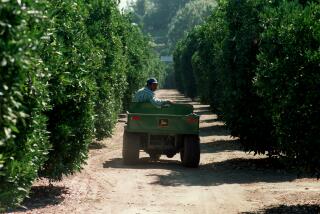State Asked to Expand Tiny Encino Historic Park
The adobe bunkhouse is still there. So is the two-story limestone farmhouse and the hand-dug lake that is replenished by an underground spring.
About the only thing that is missing 100 years after Encino’s oldest residence was used as an important Butterfield Line stagecoach stop is the place where horse-drawn Concord coaches actually stopped.
The dusty field next to the lake where Los Angeles-to-San Francisco stagecoach drivers reined their teams to a halt has been turned into a gas station. The place where the horses were unhitched and watered has become a restaurant. A nearby pasture where sweating horses could cool down in the shade of silk oak trees has been paved over for a shopping center.
But that could change if Sacramento officials approve a proposal to expand the San Fernando Valley area’s smallest state park.
State Sen. Alan Robbins (D-Tarzana) is urging state parks officials to spend $5 million in bond money to buy some of the neighboring businesses so that the Los Encinos State Historic Park can have a parking lot.
The 5-acre park in the 16700 block of Ventura Boulevard is the last remnant of the 4,460-acre Rancho Los Encinos, which dates back to 1850 when the eight-room De La Ossa Adobe was built with two-foot-thick, sunbaked, mud-and-straw bricks.
The farmhouse, constructed of limestone taken from a quarry at the southern end of what is now Woodley Avenue, was built in 1872 when the spread was turned into a sheep ranch by French Basques Eugene and Phillipe Garnier.
By 1915, all but 100 acres of the rancho had been parceled off by subsequent owners. But it wasn’t until the 1940s that subdividing of the Ventura Boulevard corridor threatened to destroy the rancho buildings.
In 1944-45, historical-minded residents began a fund-raising campaign to preserve them. In 1949, the state matched the $25,000 that the citizens had raised and the property was acquired. The five acres were classified as a state historic park in October, 1964.
But Los Encinos State Historic Park took on added importance in 1984 when construction of a 12-story office building at the intersection of Ventura and Balboa boulevards turned up 2 million artifacts.
Among them were Indian relics, stone tools and bones dating from 5000 BC and the remains of a roadhouse operated in the late 1800s by Jacques La Salle, a Frenchman.
The find was dubbed the “Lost Village of Encino” by excited archeologists. In 1985, Robbins sought $11 million in state funds to expand the park and build a museum to house the relics.
That request was whittled until only about $175,000 was allocated a year later. That money is now being spent to shore up the sagging Garnier farmhouse so its second floor can be turned into a museum for some of the relics.
Encino history buffs said they hope Robbins is successful in wrangling the parking lot allocation.
“There’s no place for anybody to park except on the street, and there’s a two-hour limit there,” said Lily Bauer, an Encino resident who has been a volunteer tour guide at the park since 1971.
Michael Crosby, a volunteer guide from Van Nuys who edits a quarterly newsletter for Los Encinos history buffs, said many of the 800 or so people who visit the park each week have trouble finding it.
Ranger Russ Kimura said that only five cars can be squeezed onto a driveway between the adobe and the farmhouse. Those cars detract from the historical ambiance, he said.
Robbins said he hopes Los Encinos will get the Proposition 70 allocation because it is the only Valley-area state park that qualifies for a share of the $54.7-million bond issue approved by voters last year.
He said officials could spend the money for land around a 1953-era shopping center to the west that houses a Pic ‘N’ Save store or land to the south, which holds an El Torito restaurant and Shell service station. The restaurant, opened in 1954, was the 100-store El Torito chain’s first outlet, company officials said.
Parks officials said they plan to send a Proposition 70 project priority list to the Legislature about March 1.
More to Read
Sign up for Essential California
The most important California stories and recommendations in your inbox every morning.
You may occasionally receive promotional content from the Los Angeles Times.











